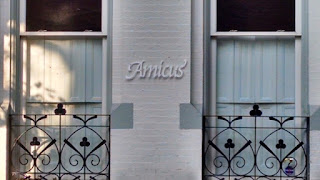Spreadsheet of Pittsburgh Public Art and blog archives
Map of Pittsburgh Public Art
 Israel Centeno (Venezuela) is a writer-in-residence at City of Asylum, having arrived in 2011. He is the author of poetry, short stories, and ten novels.
Israel Centeno (Venezuela) is a writer-in-residence at City of Asylum, having arrived in 2011. He is the author of poetry, short stories, and ten novels.He worked on the River of Words, (2014) a public art installation within the Mexican War Streets. He chose 100 words, relevant in some way to Pittsburgh. Neighbors were invited to host a “word in residence," meaning that they would display a representation of their word (designed by Venezuelan artists Carolina Arnal and Gisela Romero), on the wall, or door, or window of their houses. River of Words was wildly popular. Residents excitedly selected and suggested words that they wanted to display. If you walk the streets around Sampsonia Way, you can still spot some of the words. Some of them are bold; some inconspicuous; some stenciled on garage doors or sitting above garden gates.
The words, in Spanish and English, are references to poetry, literature, and the Pittsburgh physical and cultural landscape. For example, the names of our three rivers were included, as well as words like “zombies”. The words are made from laser-cut acrylic, vinyl letters, or even chalk.
All of the words were supposed to be removed in Dec 2014, but residents have been petitioning the Historic Review Commission to keep them. The residents that hosted a word chose one that had significance for them and they didn't want to give them up when the "temporary" art installation officially closed. Almost half the homes hosting a word were within the historic district, which made keeping them somewhat controversial.
River of Words was so much more than a temporary art installation. It's become a focal point in the debate about expanding the historic district and the role of public art in an historic district. It's beamed some light on the restrictions to modifications of these historic homes. Do the restrictions conflict with “free speech” and is this a class issue? It has really brought the discussion of public art and what it means to people to the forefront. Some homeowners decided that they did not want to become a part of the historic district because they would most likely be denied the public art option.
The project also included a drawing along Sampsonia Way, using lines and words to connect the homes along the street. “Human beings make contact with each other through the exchange of energy, affection, and knowledge,” the artists noted in their project proposal. “We’ll use words and sentences as links between houses” to create a visual array of connections and relationships. We were there the day the city showed up to sandblast the array of words and phrases off the asphalt. It was kind of sad to see it destroyed.
In addition to words, several community members hosted entire poems and portraits of poets on the facades of their homes. So far these have not been removed.







No comments:
Post a Comment